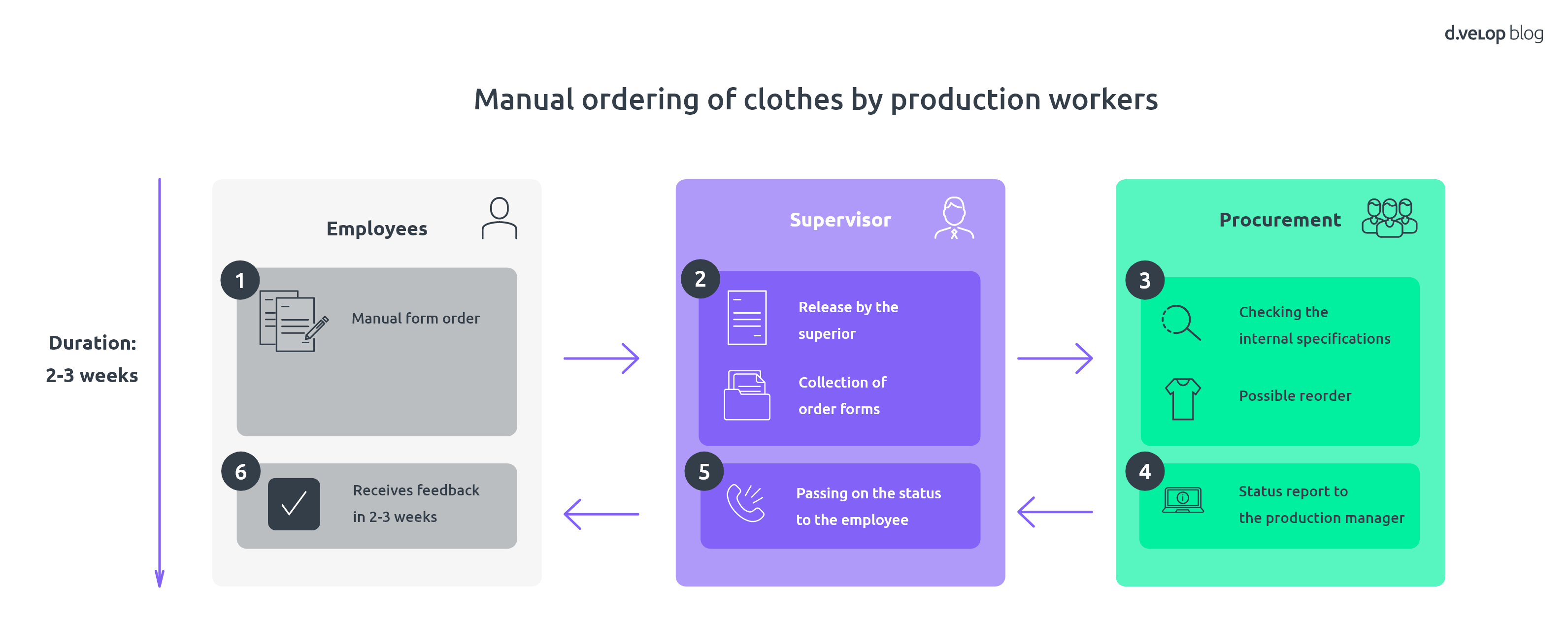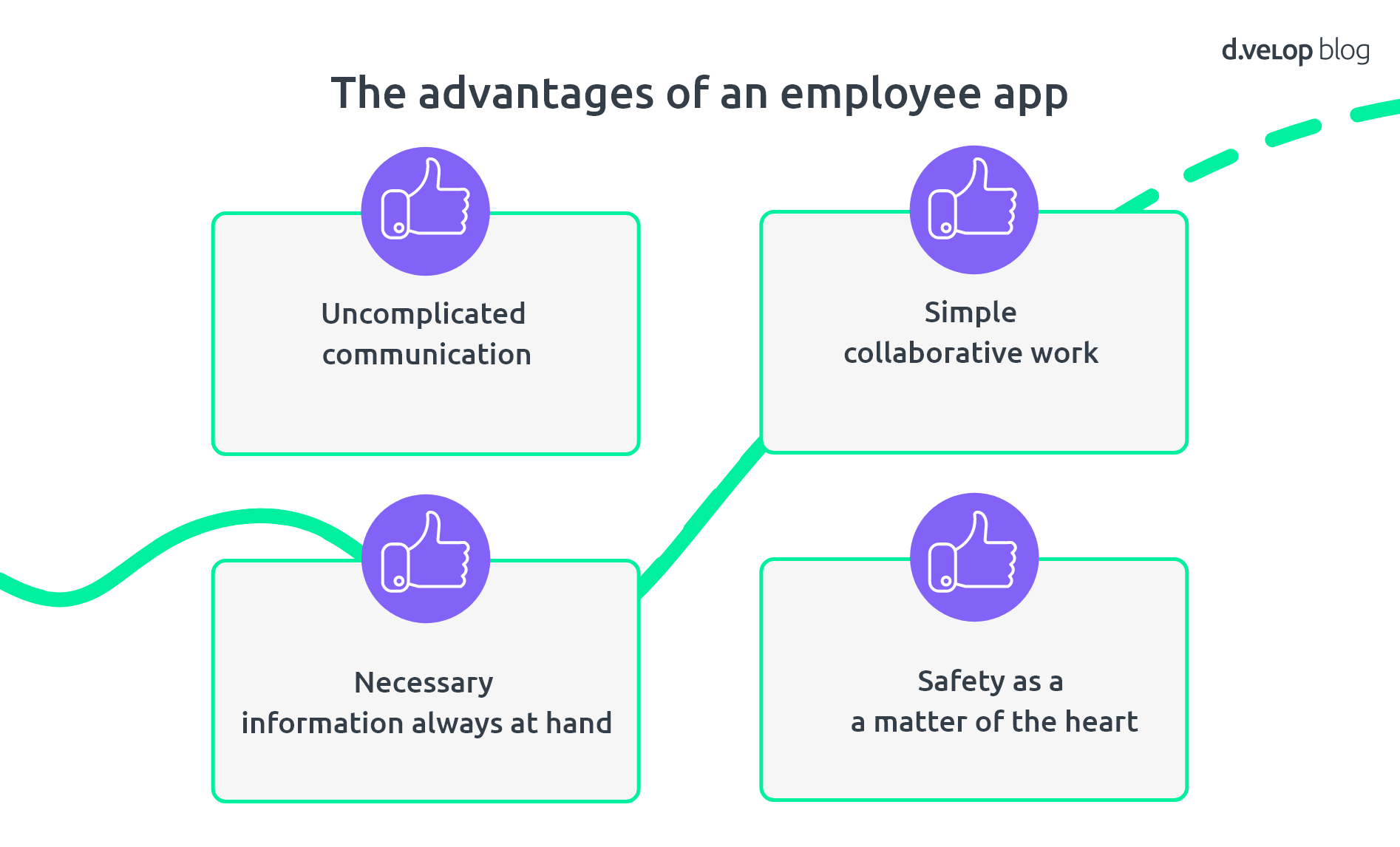For manufacturing companies, communication between colleagues and the dissemination of information throughout the company is often still a challenge. Not least because only just under half of employees have access to a permanent PC workstation. Bulky and inefficient work and communication processes, also represent additional effort that can be avoided with smart solutions.
- How can production employees without a permanent PC workstation be included in corporate communications?
- What added value do employee apps with self-services have in production?
- How can production employees take personal communication and information processes into their own hands?
In this blog article we answer these questions and show how you can use smart solutions such as an employee app to make communication processes and workflows more efficient and attractive for production employees. True to the motto:
Anyone who only improves their performance gradually in exponential times will fall behind exponentially.
Curt Carlson
Digitalisation is not a new topic
Companies are trying to convert analog workflows to digital and have intensified their efforts in this regard in recent years. According to an IHK survey on digitalisation in 2021/2022, for example, cloud applications are already established in 67 % of german companies. Nevertheless, the companies surveyed rated themselves on average with a grade of 2.9 on a school grade scale of one to six, which represents no change from the previous year.
According to the survey, the number one motive for digitalisation is to make working more flexible , cited by 51 % of companies. This should make it clear that the intensive efforts must finally become real implementations, enabling companies to close the gap to the digital pioneers, remain competitive and have a satisfied and motivated workforce.
Weak points in communication in production
In industry, it’s not just about automating individual production steps with digital and mobile solutions , but also about finding a holistic communication solution.
There are three central challenges for digital employee communication:
- Availability of production employees without a PC workstation (non-desk workers)
- Cumbersome communication processes with various media breaks
- A missing platform for internal communication processes
1. Availability of production employees
Due to the abundance of information in internal company communication, the amount of digital content that needs to be generated, managed and distributed is also growing. If we think about non-desk workers: it is difficult to reach them via common communication channels such as email, intranet, online meetings, assemblies or similar.
Of course, many companies also have the well-known bulletin board. However, it is updated manually and is not always visible to everyone due to the large areas in the production halls. The delayed and not always comprehensive provision of information, compared to emails and the intranet, for example, leads to a split between administration and production.
2. Cumbersome communication processes: media disruptions
What is a media break?
A media break describes the change of medium during the transfer of information within a process. Data once recorded digitally cannot be continuously used for further processes.
Let’s look at a typical process in industry: ordering workwear. This is often done according to the following scheme:
- Clothing is requested manually using a physical order form by production employees
- Submission of the form to production management
- Approval by the supervisor
- Collection of the order forms in a filing basket for bundled forwarding to the purchasing department
- Purchasing checks whether there are internal requirements for a certain quota of clothing and if so, whether this has already been exhausted by the employee
- If not, whether the desired clothing is still in stock or needs to be ordered
- Status report via email or telephone to the production manager
- Passing on the status to the employee
Here we see that a wide variety of channels are used and important time is lost as a result. The susceptibility to errors also increases with every media disruption, for example when paper lists are typed out manually. Not to mention the time-consuming tracking of work steps by employees, who wait a long time and possibly, even in vain for the clothes they ordered.
3. Lack of a holistic platform for internal communication
The dominant communication channels in companies in 2021 are emails (100 %) and landline telephones (98%). Smartphones are catching up with 89 %, online meetings with 67 %, messenger services with 66 % and employee portals with 60 % ( digital association Bitkom ). The fact that in 2016 most business processes were paper-based in one in three companies (34 %) and in 2021 only in almost one in four (23 %) is already progress.
However, there are still a number of communication channels used in parallel, meaning that information is lost along the way or parts of the workforce are not reached. What is needed is a holistic solution that everyone in the company can access, regardless of where they work.
Demo for the d.velop employee app 💻
Book your individual software demo for the d.velop employee app with just a few clicks. Let our experts show you the software live and ask your questions directly.
An app as a holistic solution for communication in production
There are already good examples in industrial companies, where apps support successful internal communication.
1. Quickly find regulations, maintenance and emergency plans through mobile communication in production
Employees without a permanent job find it much more difficult to access information and communicate with other colleagues in an emergency.
When servicing large systems or machines, for example, production employees often come across different regulations that are intended to protect against the risk of explosion, fire or poisoning. Maintenance teams often have limited or no access to important, maintenance-related information and communicate primarily via telephone and intermittently via email. This condition has serious implications for safety in industrial companies.
A mobile app that provides access to important and up-to-date information for all employees can ensure compliance with important regulations and therefore the safety of the workforce.
Smartphones are owned by a high proportion of workers. Then why not use the app on your cell phone during the production or assembly time? In this way as required, employees can quickly obtain information and interact.
2. Immediate notification of damage by employees via app
If an employee discovers damage to a system, they can use an employee app to react immediately and communicate the damage. Damage reports can be processed via the operational workflows of an employee app without losing important information or time.
3. Shift and machine occupancy plans always in your pocket
Especially when the production or manufacturing halls are either large or even spread across different locations, it is important to have the necessary resources in the right place, at the right time.
By providing via an app, the necessary overviews of machine occupancy, shift planning and, if necessary, the location of the activity, this makes communication much easier.
This means that production employees always have an up-to-date overview at hand, avoiding the risk of having incorrect information or being out of date, for example due to illness or vacation.
4. Increased responsiveness and adaptability
Industrial companies repeatedly experience that shortly before or during a special production, changes are requested by customers or that urgent production requests arise.
But how can you deliver the desired products quickly, if internal communication itself takes a long time?
Communication in production: Apps as an interface between order planning and production employees
What is missing here is a connection between the order planning system and the order realisation on the machine. In order to meet spontaneous customer requests and urgent delivery dates, production information can be quickly distributed. By using push notifications or chat within the app, changes can be considered by production or manufacturing. For example, unplanned orders that use the same tools during production can be optimally used, or smaller orders can be planned when the machine is idle.
In addition to this information distribution, employees have the opportunity to react to changes and interact with production planning via d.velop community chat.
Search functions also make it possible to find information quickly, instead of having to ask for it over the phone, which creates delay.
5. Personal concerns as self-service via app
An employee app goes far beyond a company intranet and therefore also replaces the bulletin board. It can do more than just communicate, because it also supports employees in exchanging information about personal concerns. Requests, such as holiday and procurement requests, but also sick notes can be conveniently sent to the company from a smartphone, regardless of time and place. Thanks to Employee Self Services, employees can manage and manage their personal processes themselves.
6. E-learning when and where you want
The topic of e-learning for companies is also becoming increasingly important. Training courses and lectures can be completed by all employees via the app. This ensures that all the latest findings and information actually reach the entire workforce.
7. Never go through folders again: employer documents in the digital mailbox
Employer documents can easily be delivered to a digital mailbox via the app. The d.velop postbox makes it possible to integrate pay slips and insurance documents into the holistic platform, so that there is no longer any need for a media break.
8. Security and Privacy
Of course, we are aware that an employee app processes very sensitive data every day. That’s why data protection has a very high priority and is guaranteed with the most modern systems in accordance with compliant data protection, via an ISO-certified data center. The applications can be operated both via the d.velop cloud and on-premises. In addition, the data is encrypted end-to-end and access can only take place via SSL and with authentication. There is neither user tracking nor reading of the smartphone, so it can also be used on private cell phones, without any problems and separate work cell phones are no longer required.
The advantages of an employee app at a glance:
Smart and uncomplicated communication:
- Between order planning and production employees
- Between employees and the HR department
- Between colleagues via d.velop community chat
Necessary information always at hand:
- Quickly find regulations, maintenance and emergency plans
- Immediate damage report by employees via app
- Shift and machine occupancy plans always in your pocket
Working together has never been so easy:
- Increased responsiveness and adaptability through real-time communication
- Quickly find information and the right contact person via the company contact book
Security as a matter of the heart
- End-to-End Encryption
- Access only via SSL and with authentication
- Compliant use of private devices
- ISO certified data center
- No user tracking and reading of the smartphone
Conclusion
An employee app offers various options for involving production employees in corporate communication. Finally avoiding media disruptions and giving internal communication its own platform.


